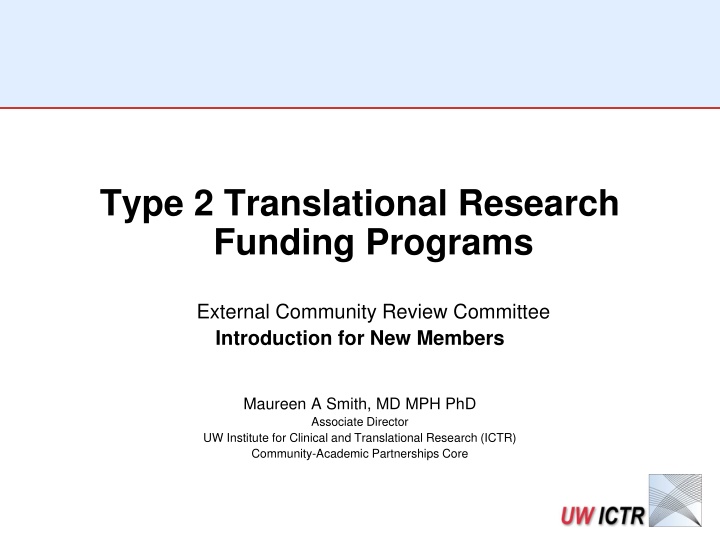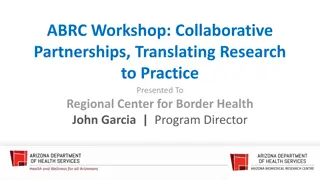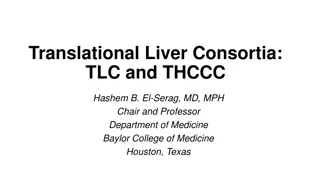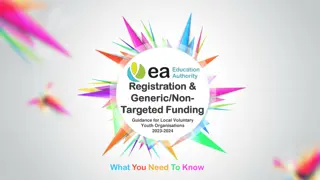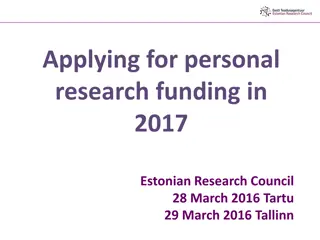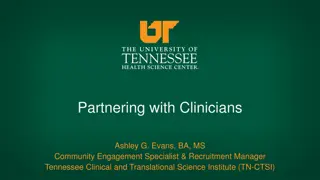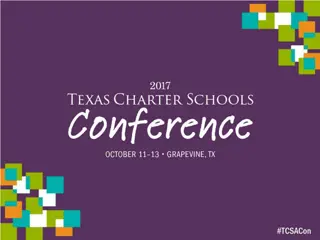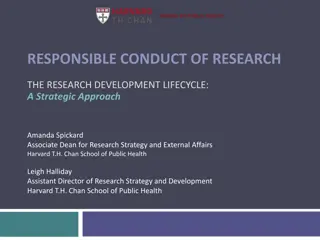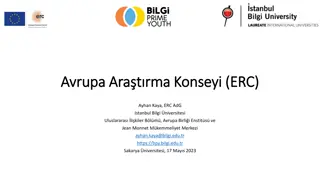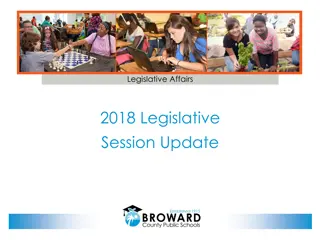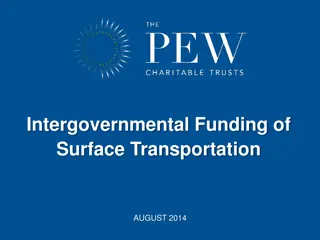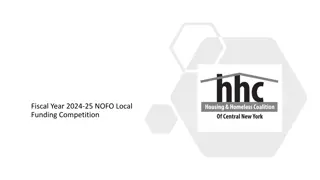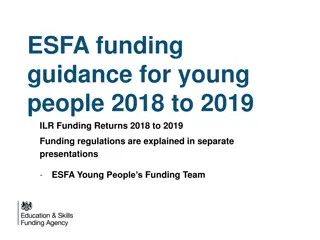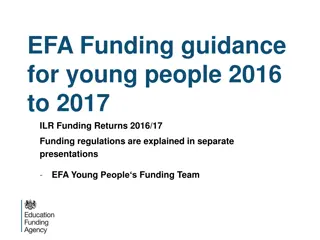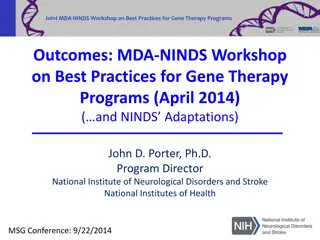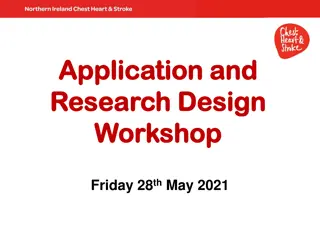Type 2 Translational Research Funding Programs
This introduction provides insights into Type 2 Translational Research Funding Programs, emphasizing the evolution to Type 2 Translational Research, the role of the ICTR and Community-Academic Partnerships Core, and the continuum of translational research according to the NIH view. The presentation also highlights gaps in knowledge application and shares examples of past funded projects, offering a comprehensive understanding of translational research in community settings.
Download Presentation

Please find below an Image/Link to download the presentation.
The content on the website is provided AS IS for your information and personal use only. It may not be sold, licensed, or shared on other websites without obtaining consent from the author.If you encounter any issues during the download, it is possible that the publisher has removed the file from their server.
You are allowed to download the files provided on this website for personal or commercial use, subject to the condition that they are used lawfully. All files are the property of their respective owners.
The content on the website is provided AS IS for your information and personal use only. It may not be sold, licensed, or shared on other websites without obtaining consent from the author.
E N D
Presentation Transcript
Type 2 Translational Research Funding Programs External Community Review Committee Introduction for New Members Maureen A Smith, MD MPH PhD Associate Director UW Institute for Clinical and Translational Research (ICTR) Community-Academic Partnerships Core
Goals for this morning Overview of the evolution to Type 2 Translational Research Overview of the Institute of Clinical & Translational Research (ICTR) and the Community-Academic Partnerships Core
The NIH View: The Continuum of Translational Research Basic Research NIH Type 1 Methods Development Translational Research Bench to bedside Publish Efficacy Trials
The NIH View: The Continuum of Translational Research Basic Research NIH Type 1 Methods Development Translational Research Bench to bedside Publish Efficacy Trials Effectiveness Research NIH Type 2 Translational Research Bedside to community Implementation Research Policy Research
What we knowand what we dont We know what to do Rigorous research on specific interventions Large body of evidence-based knowledge We don t know how to make sure that our knowledge isn t applied or isn t applied well Reasons for gap are poorly understood Lack widespread implementation of effective treatments
A Type 2 Translational Research question will 1. Examine the gap between knowledge and practice a. Are known efficacious interventions used in community settings? Why or why not? b. Are they applicable in community settings? Why or why not? 2. Develop, evaluate, disseminate behavioral interventions to improve practice a. Change in individual behavior? b. Change in organizational behavior? c. Systems redesign? 3. Examine impact of policies or policy changes
Examples of past funded projects Diabetes assessment and program implementation with schools & community organizations Systems assessment of ICU and cardiac care Obesity prevention program feasibility studies Participatory photo mapping as community-engaged assessment tool to impact policy Tobacco use, drug addiction and medication adherence with community-based organizations Patient-centered and family-centered care assessments Asthma medication adherence with pharmacists in rural settings Screening and primary care for chronic diseases (chronic kidney disease, depression, colon cancer)
Background: UW Institute for Clinical &Translational Research (UW ICTR) Institute for Clinical & Translational Research 5 year funding from NIH Matching funds from UW and Wisconsin Partnership program The goal of the UW ICTR is to create an environment to transform health-related research at the University a continuum extending from investigation through discovery to translation into practice linking research to real and measurable improvement in health
UW ICTR Partnerships Formal Partnerships School of Medicine and Public Health School of Nursing School of Pharmacy School of Veterinary Medicine College of Engineering Marshfield Clinic
ICTR-Community Academic Partnerships Program (ICTR-CAP) Long-term goal: to support collaborative, multidisciplinary research that solves problems in translating new and existing knowledge into improvements in clinical practice, community health programs and policy.
ICTR-CAP Type 2 Translational Research Funding Programs External Community Review Committee Scoring Session Maureen A Smith, MD MPH PhD Associate Director UW Institute for Clinical and Translational Research (ICTR) Community-Academic Partnerships Core
Goals for Today Discuss and score Community Collaboration proposals (goal: fund up to 2) Discuss and score Pilot proposals (goal: fund up to 7)
T2TR Program Goals Pilot Program ($50,000 for 1 year) To gather pilot data leading to future larger research projects that discover the best ways to translate new and existing findings into improvements in clinical practice and community health programs. Community Collaboration Program ($200K for 2 years) To support community-engaged research partnerships that solve problems in translating clinical and health-related scientific knowledge into meaningful changes into clinical practice or community health programs.
A Type 2 Translational Research question will 1.Examine the gap between knowledge and practice 2.Develop, evaluate, disseminate behavioral interventions to improve practice 3.Examine impact of policies or policy changes
NIH definition of community (as defined by NIH for PA-08-077, Community Participation in Research R01) Community refers to target populations that may be defined by: geography race ethnicity gender sexual orientation disability, illness, or other health condition or to groups that have a common interest or cause, such as health or service agencies and organizations health care or public health practitioners or providers policy makers or groups with public health concerns
NIH definition of community organizations Tribal governments & colleges state or local governments independent living centers other educational institutions such as junior colleges advocacy organizations health delivery organizations (e.g., clinics, hospitals, and networks) health professional associations non-governmental organizations Federally-qualified health centers Community-based organizations refer to organizations that may be involved in the research process as members or representatives of the community. Possible community partners include, but are not limited to:
Community engagement criteria for pilots grants Applicants are asked to address: Who is the constituency or group that will benefit from research? Please describe how a representative of that community/constituency is involved in the research.
Community engagement criteria for Community Collaboration grants Applicants are asked to address: Who is the constituency or group who will benefit from the research? When did collaboration begin and outline collaboration activities to date. How is this community/constituency, or a representative thereof, involved in the research; what is their role? Plans for sharing results of research with the end-users of research. Plans for sustained partnership including information about sustained funding to support this partnership.
The T2TR Grant Review Process 1. Technical Review 2. Scientific Review by three experienced researchers 3. ICTR-CAP Study Section Scoring Proposals sent forward to ECRC if scored up to or better than minor scientific weaknesses 4. External Community Review Committee makes final funding recommendations Discussion of process at the end of the meeting
Changes from previous ECRC In addition to abstracts, ECRC packet now includes Section of the proposal that directly addressed the question How will you engage the end users of your research? Letters of support from community collaborators New scoring paradigm based on NIH ECRC scoresheet allows all scores to appear on one page for easier decision-making
Components of Scientific Review Significance: Important problem? Investigators: Well suited to conduct project? Scientific Excellence & Approach: High scientific merit? Innovation: New avenues of investigation? Engagement of end users of research: Consider criteria for each grant program Attention to special criteria: collaborations, NIH targeted projects, novel methodologies Justification of type 2 translational research Likelihood of leading to new peer-reviewed funding Budget: Feasible? 1. 2. 3. 4. 5. 6. 7. 8. 9.
NIH Scoring for Scientific Merit Scores 1 * Descriptor Exceptional Scientific Anchor Exceptionally strong potential for impact; essentially no weaknesses Outstanding Extremely strong potential for impact with negligible weaknesses 2 * Excellent Very strong potential for impact with only some minor weaknesses 3 * Very Good Strong potential for impact with numerous minor weaknesses 4 * 5 Good Strong potential for impact but with at least one moderate weakness 6 Satisfactory Some potential for impact but hampered by moderate weaknesses 7 Fair Some potential for impact but hampered with at least one major weakness Limited potential for impact and a few major weaknesses 8 Marginal 9 Poor Limited potential for impact and numerous major weaknesses * Proposals with highest scientific merit forwarded to ECRC
Impact Scoring Guide Scores Descriptor Exceptional Impact Anchors Exceptionally strong potential for impact in a highly significant area 1 2 Outstanding Extremely strong potential for impact in a highly significant area 3 Excellent Very strong potential for impact in a highly significant area 4 Very Good Strong potential for impact in a highly significant area 5 Good Strong potential for impact in a moderately significant area 6 Satisfactory Some potential for impact in a highly significant area 7 Fair Some potential for impact in a moderately significant area 8 Marginal Limited potential for impact in a highly significant area 9 Poor Limited potential for impact in a moderately significant area Please use entire scoring range.
How to think about priorities Significance: This research area addresses important problems or critical barriers to progress in advancing/improving clinical practice and/or community health. The project has long-term potential to contribute to the advancement of health. Priority: The research area addressed by this proposal should be an investment priority for UW-Madison and Marshfield. Community: This research project, based on the criteria for the specific grant program, effectively incorporates the input of community partners/end users.
Conflict of Interest Do not score write COI in the score box Reviewer has responsibility or involvement in the project or has advised or consulted on development Reviewer or family member has employer or investment relationship with PI or key personnel
TODAY 1. Proposal in binder separated by grant program 2. Maureen Smith will introduce each proposal 3. ECRC member discussion 4. ECRC scoring (or COI) after discussion of each proposal 5. Average of final scores will become the final score of the ECRC
Discussion of Impact & Scientific Merit Scores
Your feedback Your thoughts about this process have improved it every year. What would you like to share to help us continue this trend?
